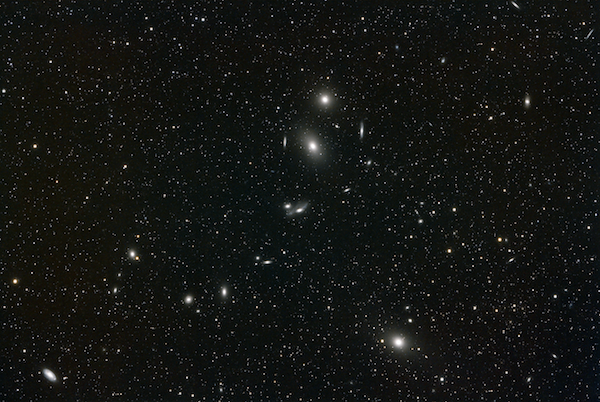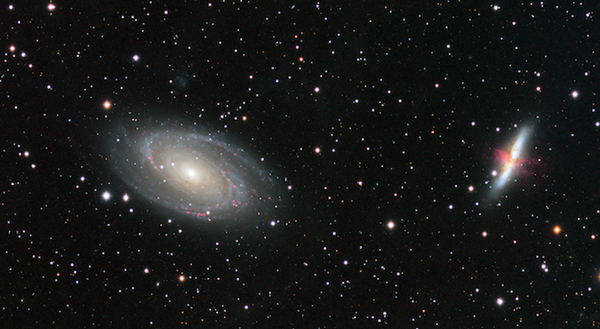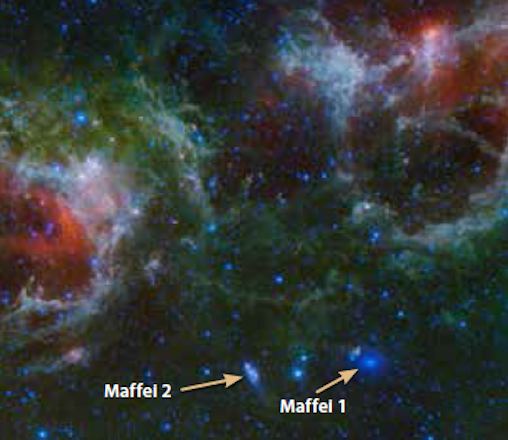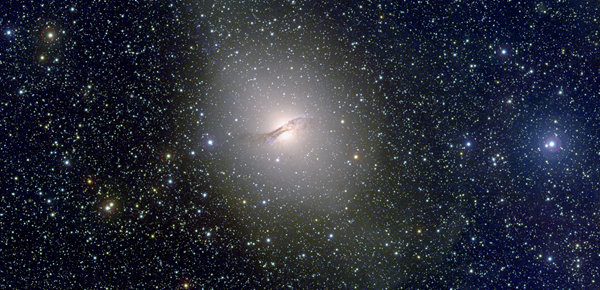Many of those definitions involve gravity, which works on a variety of scales. A star is a gravitationally bound clump of hot ionized gas, where nuclear fusion at the core generates energy. A galaxy is a gravitationally bound system of gas, dust, and millions or billions of stars. A galaxy group comes next, and it usually holds a few dozen members. A galaxy cluster with hundreds or thousands of galaxies is a larger gravitationally bound object, where the mutual attraction is strong enough that even cosmic expansion won’t pull the pieces apart.
In this hierarchy of scales, what comes next? Now definitions become more complex. To determine which galaxies belong to a given structure, one needs to define the structure they’re talking about. But here, it’s not so simple. “If you talk to astronomers and cosmologists about gravitationally bound systems, you’ll get a fairly coherent set of answers,” says Stanford University cosmologist Risa Wechsler. But while a “group” and a “cluster” is each a gravitationally bound system, anything larger is not. “When you start to talk about larger systems, there’s not actually really clear definitions,” she says.
Astronomers know that some clusters clump together into a larger region. But there, the effects of the pull of gravity differ from astronomers’ definition of a gravitationally bound system. Nearby groups and clusters — each of which is gravitationally bound and experiencing the gravitational pull of a larger structure — lie within what many astronomers call the Local Supercluster, which contains our Local Group. This structure also sometimes goes by another name: the Virgo Supercluster, after its largest constituent cluster of galaxies, Virgo. That large cluster also happens to lie near the supercluster’s center.
But again, the picture is not so simple, and definitions are key. The Local Supercluster and the problem of defining its boundaries harken to when extragalactic astronomy was in its infancy.
University of Hawaii astronomer R. Brent Tully knows our local structure arguably better than anyone. Since the mid-1970s, he and his colleagues have mapped nearby galaxies and measured their motions, all to piece together a complete picture of our so-called local universe.
Tully attributes the Local Supercluster’s name and definition to the astronomer Gérard de Vaucouleurs. In a series of several papers in the 1950s, de Vaucouleurs described an overdensity of galaxies in one region of the sky. The Local Group and other nearby galaxies appeared to be part of a larger structure, which he first called the Local Supergalaxy, based on evidence suggesting that larger structure was rotating around a central point.
The term supergalaxy came from the idea of a rotating “galaxy” made up not of stars, but galaxies. By the end of the decade, de Vaucouleurs, in his November 29, 1958, Nature paper, began referring to the structure instead as a supercluster, writing, “This analysis supports the conclusion that the local supercluster of galaxies is an irregular assembly of groups, clouds and clusters dominated by the Virgo cluster in its centre.”
Whereas a galaxy cluster is typically a dense, spherical conglomeration, the Local Supercluster’s “irregular assembly” arises from the constituent groups, clouds, and clusters taking on an ellipsoid shape similar to a jellybean. At its widest, the Local Supercluster extends about 100 million light-years. Distance measurements place us as observers in the Local Group about two-thirds to three-fourths away from the center.
Astronomers have continued mapping and defining the Local Supercluster’s structure in the many decades since its discovery. They now know the Local Group lies in a “wimpy little filament” stemming from the Virgo Cluster, says Tully. Our neighbors Centaurus A, the M81/M82 group, and the Maffei galaxy group lie between us and the center of our supercluster. The Ursa Major groups sit close to the Virgo Cluster.
As detection and analysis techniques improved, however, astronomers realized the Virgo Supercluster was not a gravitationally bound object. Its story is much more complicated, and a simple definition from the 1950s perhaps wouldn’t suffice.
De Vaucouleurs and other astronomers had originally looked at the rainbowlike spectrum of light from galaxies in the supercluster. Measuring how much that spectrum has shifted compared with a stationary source on Earth tells us how fast the galaxy is moving — and how far away it is. Astronomers combine that distance with the galaxy’s position on the sky, and do that for hundreds of galaxies, and then voilà! A 3D map of galaxy distribution within the supercluster.
By the 1980s, astronomers began to understand the detailed dynamics, or motions, of the structures apart from the universe’s background of cosmic expansion. No longer were they limited to mapping points of light on the sky. Now they could look at underlying structure by following galaxies’ movements.
That structure was surprising. Instead of all galaxies in the Local Supercluster moving toward the Virgo Cluster, and therefore the center of the supercluster, they seemed to be moving toward a spot that didn’t align with Virgo. Even the Virgo Cluster was moving toward that same area. Astronomers refer to that mysterious region as the Great Attractor.
But what lies beyond the Local Supercluster? Like a leaf carried along by a rushing river toward a lake, each galaxy follows the flow of gravity. Smaller lakes eventually feed into large basins of water. The Local Supercluster is one of those smaller lakes; what does it feed into? What enormous body of water contains the Great Attractor?
To solve that mystery, astronomers needed to unravel the many different movements of each galaxy. The largest comes from cosmic expansion, called the Hubble flow, which describes the expansion of the universe that carries things farther apart. But a smaller and more important motion to determine the structure in which a galaxy lies results from the gravitational pull between galaxies. This motion, called peculiar velocity, subtracts the Hubble flow. “The peculiar velocities are telling us where the mass is,” says Tully.
Over several years, Tully and his colleagues — including Hélène Courtois of the University of Lyon and Yehuda Hoffman from the Hebrew University of Jerusalem — have measured and mapped the motions of nearly 20,000 galaxies in the local universe. Their observations yield three numbers for a galaxy’s position, one number for its radial velocity (its velocity along our line of sight), and one number for the motion’s uncertainty. That’s five numbers each for 20,000 data points. But those data points aren’t isolated numbers; they all relate to one another because they’re all correlated through gravity. The goal of the team’s analysis was to figure out how.
Tully and his colleagues published their analysis December 1, 2017, in The Astrophysical Journal. Their paper shows how the Local Supercluster, defined 70 years ago, relates to an even larger volume of the local universe. The Great Attractor is the center of what is now called the Laniakea Supercluster, and the Local Supercluster is just an assemblage of that larger structure. They call Laniakea a true supercluster because anything within its boundaries will move gravitationally toward it, while whatever lies beyond those boundaries will move away.
So, what becomes of the previously known Local, or Virgo, Supercluster? “It’s more of a historical interest,” says Hoffman. The Local Supercluster, he adds, played an important role in the effort to tease out the structure of galaxies in our local universe, encouraging astronomers to keep observing farther out.
Through studying more distant objects, scientists have found that our nearby galaxy clusters belong to larger conglomerations that are all intertwined in a vast cosmic web. Multiple filaments of gas that make up this web meet at nodes that hold groups or clusters of galaxies. Between nodes and filaments are enormous gaps of material, called voids. Whereas nodes have excess material, voids have less. These underdense regions are just as important as the overdense ones, says Hoffman. He, Tully, and their colleagues have described just how important one of these nearby large voids is. An empty region can’t push material away, but it does pull in far less than a massive region would. That means any gas or galaxies in between would move toward a more massive region — in this case, away from the local void and toward the Great Attractor.
But in the end, even those movements are lost in the pull of the universe’s accelerating expansion. In the far future, perhaps 100 billion years from now, individual galaxy clusters will condense and collapse from self-gravity. According to work by Wechsler and her colleagues, cosmic expansion will pull everything else apart, so that anything outside the Virgo Cluster will be so far away that light from those other galaxies will never reach Virgo — or us.
“Being an astronomer in 100 billion years will be really boring,” Wechsler adds. But on the bright side, astronomers won’t still be arguing about the definition of a supercluster.













